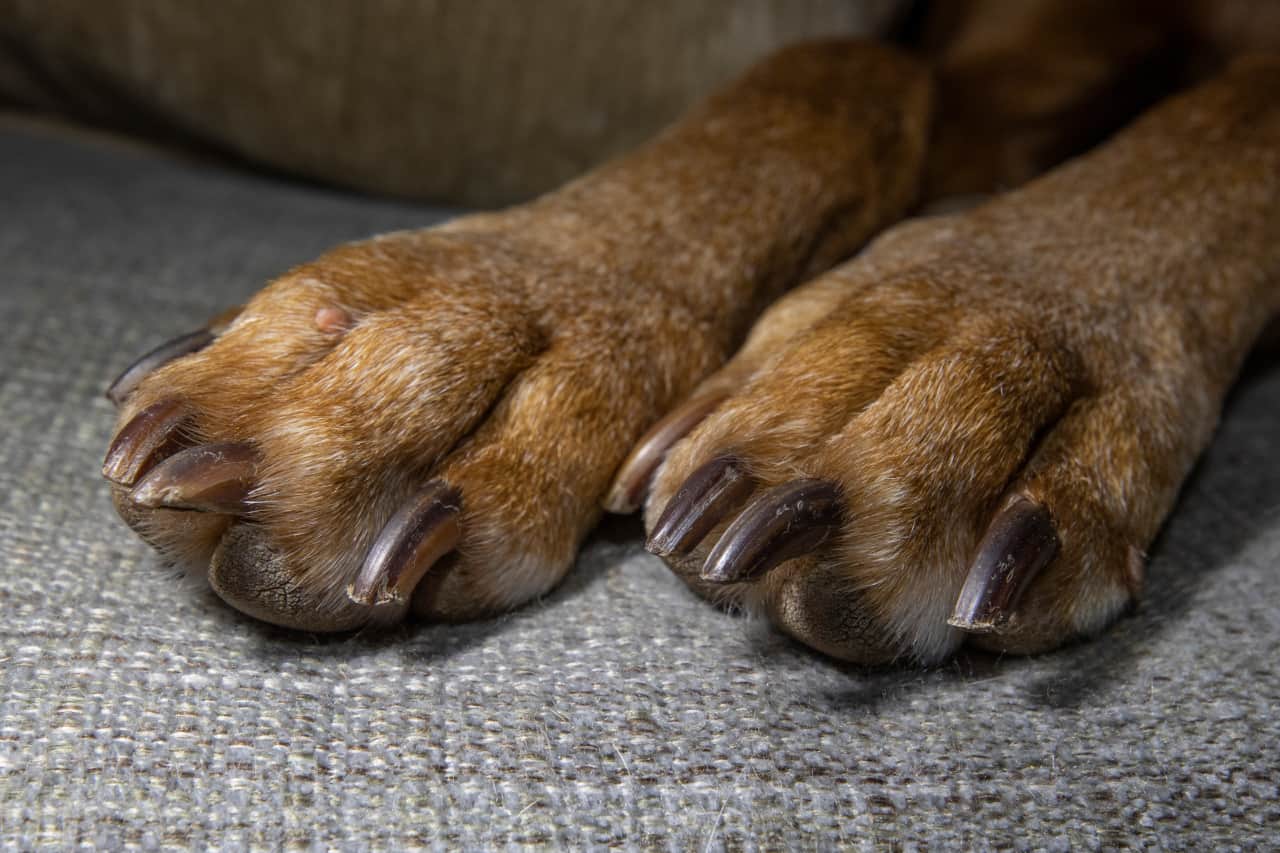Many people overlook a dog’s nails when considering the health of their dog. Dog’s nails need to be trimmed regularly, and some owners prefer to do the job themselves. Veterinary consultation charges and prices to do a simple nail trim seem exorbitant. The question that most owners ask is, how long should the nails be? Vizslas have nails that grow quickly and grow very long. It is useful to know precisely how long the nails should be so that the job can be completed as fast as possible.
A Vizsla’s nails should not touch the floor when walking or standing. If the nails click on the floor as the Vizsla walks, then the nails are too long, and it is time to trim them. Nails should be cut so that the nails are four to five millimeters beyond the quick line.
This article will discuss the nails’ anatomy, how long the nails should be, the consequences of long nails, and how to cut the nails. Information on nails is useful for any Vizsla owner bearing in mind how quickly and how long Vizslas nails grow.
Anatomy Of A Canine Nail
A dog’s nails consist of keratin, which is a modified form of skin cells. The nails have an outside hard shell and a soft inner core known as the cuticle.
The cuticle contains the blood and nerve supply. In white nails, you can easily see the pink cuticle in the center of the nail. It is harder to see in black nails. The pink cuticle area is also known as the quick.
Effect Of Terrain On Dogs’ Nails
Vizslas that commonly walk or run on hard surfaces such as cement, tar, or stony ground will wear their nails down and will not need to have their nails trimmed. Some dogs walk and work in areas where the soil is soft, and their nails grow too long.
Others have nails that overgrow, and no amount of hard surfaces wear their nails down, requiring the nails to be trimmed. Pet dogs usually have to have their nails trimmed, and working dogs may need nails trimming less often.
Correct Length For Dog Nails
There are some easy methods to determine if a dog’s nails are too long. Any clicking when the dog walks indicate that the nails are touching the ground, and the nails are too long. Examine the dog when standing.
If the nails touch the ground or are turning sideways, then the nails are too long. The nails should not protrude past the footpads. Their nails should have 4-5mm length beyond the quick or cuticle.
How To See The Cuticle On A Black Nail
A strong flashlight can help to identify the position of the cuticle in a black nail. A more reliable method is to look at the underside of the nail.
There is a groove in the nail where there is only the hard outside layer. Where the groove ends, it is easy to see the soft cuticle or quick. When clipping a black nail, turn the foot over regularly to check the position of the cuticle.
Dewclaws
Dewclaws may be equated to human thumbs. They are found on the inside of the foot and do not touch the ground. Some dogs have double dewclaws, but this is not the case in Vizslas.
Dewclaws usually only occur on the front legs, but some dogs may also have them on the back legs. Dewclaws need to be clipped along with other nails. They may get hooked and tear, causing painful injuries to the dog.
As a result, some vets prefer to remove dewclaws to avoid injuries. Dewclaw removal may be especially pertinent for Vizslas, whose nails grow very long.
Is It Bad For A Vizsla’s Nails To Be Too Long
Vizslas with nails that are too long are prone to a variety of problems. The first is that nails can quickly hook in grass clumps, bushes, or when playing.
The result is a tear where the nail pulls loose from the nail bed. It is a severely painful condition, and most dogs become very protective of that foot.
Nails may also crack and split. A split nail is challenging to manage and may require that a vet surgically removes the nail.

Long Nails And Arthritis
Long nails on a Vizsla may cause deformities of the toes if left for an extended period and contribute to arthritis development. Long nails push against other structures in the toes causing excess pressure, deforming bones, and joints.
Wound Management For Nail Injuries
Injured nails tend to bleed a lot. Stop the bleeding by applying styptic pencil or powder, which cauterize the blood vessel.
Cornstarch can stop bleeding if styptic pencils are unavailable. Damp tea bags are also a useful, easy means of stopping bleeding. The tannin in tea causes the blood to clot.
Once the bleeding has stopped, apply antibiotic cream and bandage the foot. When wrapping the foot, ensure there are no lumps or folds in the bandage as this can cause a pressure point that may damage tissue.
When Do Nail Injuries Need Veterinary Attention
Anytime a Vizslas has a nail injury that requires the nail to be removed, it is essential to consult a veterinarian.
It is painful to cut into the cuticle or nail bed, so these procedures should be done under sedation. Any sign of infection or pus around the nail needs prompt attention by a veterinarian.
Health Conditions Affecting Nails
If one nail on your Vizsla is a problem, it is probably a result of trauma. If the problem is seen in more than one nail, it may be due to a systemic infection or condition.
Systemic bacterial and fungal infections can cause nails to become brittle and deformed. Autoimmune disorders such as lupus can also cause thick abnormal-looking nails.
Nail Caps or Covers
These days it is not just ladies who go to get gel nails. Dogs can have nail caps or covers fitted. These are usually made from vinyl. The first reason to use nail caps is to help old and arthritic dogs grip slippery surfaces more easily.
The second reason to fit nail caps is to prevent your Vizsla from scratching furniture, wooden floors, and sometimes even people. Nail caps come in various colors, and some owners like to put them on their Vizslas as a fashion item.
Trimming a Vizsla’s Nails
It is essential to start playing with your Vizsla puppy’s feet and do trims when necessary. Vizslas have nails that grow quickly, so it is highly beneficial to accustom the dog to regular foot inspections and nail trimming. Nail inspections and trims should be kept positive, with the dog being rewarded for complying with this task.
Regular Trimming
A Vizsla’s nails should be trimmed regularly. It is best to inspect the feet every ten to fourteen days. Any excess nail length should be cut away. Leaving the nails to get too long makes it a much more difficult task for the owner and can cause potential pain to the dog.
Nail Trimming Equipment
There are a variety of tools for trimming nails. Most people are familiar with one of two types of clippers: a guillotine type and a scissor type. The guillotine type can cause split nails and other complications.
An alternative to clippers is to use a Dremel with a grinding disc attached to grind the nails down gently. The benefit of the Dremel is that it is easier to avoid cutting too deeply. It also rounds the nails and prevents sharp edges from forming. Some dogs object to the Dremel tool’s sound or don’t like the feel of the vibration on their toes.
Conclusion
Vizslas have fast-growing nails that need regular trimming. Nails should be cut a few millimeters below the cuticle or quick not to cause painful damage.
Nails should not protrude past the pads of the foot. The owner or a veterinary professional can trim nails. Regular trimming prevents injuries to the nails and toes. Dogs should be accustomed to having feet inspected and nails trimmed from an early age.


